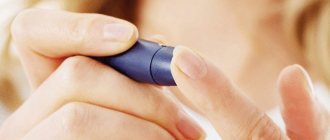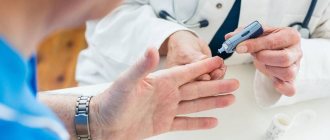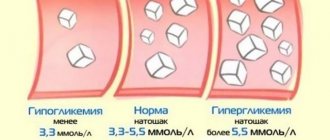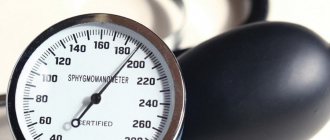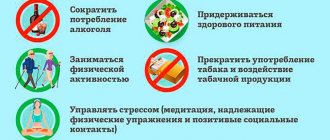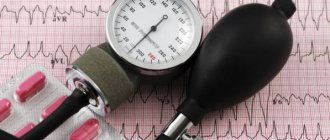A blood sugar test is one of the mandatory annual tests for people over 30 years of age. And if the result of this analysis is higher than normal, everything is more or less clear, then what are the causes of low blood sugar in an adult is not always clear. Also, a person may be bothered by something for a long time, but even a doctor often cannot connect these symptoms with low blood sugar.
A decrease in blood sugar levels below normal is called hypoglycemia. The normal level of sugar in blood taken from a finger is from 3.3 to 5.5 mmol/l.
The reasons for low blood glucose levels are varied. Most often, this is the wrong tactic in the treatment of diabetes mellitus, both types 1 and 2, regardless of the use of insulin. Hypoglycemia may also indicate the presence of severe diseases of internal organs, pancreatic tumors, or prolonged fasting.
Among the main reasons for low blood sugar in adults are the following:
- In patients with diabetes mellitus:
- excessive administration of insulin;
- taking an extra dose of tablet medications;
- violation of diet, fasting;
- excessive physical activity without additional food intake;
- severe concomitant diseases of internal organs;
- alcohol intoxication.
- Insulinoma.
- Diseases of the gastrointestinal tract, surgical operations.
- Long-term adherence to a diet with a sharp restriction of carbohydrates in food.
- Severe liver diseases (cirrhosis, cancer, hepatitis).
- Endocrine diseases (adrenal insufficiency, dysfunction of the pituitary gland, thyrotoxicosis).
- Heavy physical activity.
- Conditions accompanied by increased glucose consumption (pregnancy, lactation, diarrhea, vomiting).
- Tumors (stomach, intestinal, liver cancer, leukemia).
- Alcoholism.
- Taking certain medications.
Mistakes in the treatment of diabetes mellitus
A decrease in blood sugar levels in patients with diabetes is quite common. It should be noted that for such patients, the blood sugar level at which they feel unwell is an individual figure. Often, even with a reading of 6–7 mmol/l, dizziness and sweating begin to bother you.
Every patient with diabetes should know what types of insulin there are, where to administer them correctly and after what time it is necessary to eat. He must remember that with planned physical activity or a decrease in the amount of food eaten, the insulin dose should be reduced. Avoid drinking large amounts of alcohol because it blocks enzymes that help form glucose.
Patients with diabetes mellitus taking tableted hypoglycemic drugs, especially from the group that enhance insulin secretion (gliclazide, glibenclamide, etc.), should not try to increase the dose of the drugs on their own, even if blood sugar levels are elevated. Many drugs have a dose, after exceeding which they simply stop enhancing their effect. However, they can accumulate in the body and cause severe hypoglycemia with loss of consciousness.
By the way, we recommend reading the article Types of insulin and methods of insulin therapy for diabetes mellitus
Types of pathology
Hypoglycemia or a critical decrease in the capacity of sugar in the blood is a disease that can develop both in diabetics and in patients who do not have problems of this kind in the pathogenesis. As for diabetics, the development of hypoglycemia is often provoked by changes in compensatory medications, incorrect calculations of insulin doses, physical or psychological stress on the body, irrational or poor nutrition, and the use of alcoholic beverages or drugs. For patients who do not have prerequisites for diabetes in the pathogenesis, the development of the disease can progress according to two scenarios that predetermine the type of illness: fasting or a response process of developing hypoglycemia. Let us consider the features of each form of pathology with an analysis of the fundamental prerequisites for its development.
Fasting hypoglycemia
The progression of fasting hypoglycemia is diagnosed in patients in situations where a decrease in blood glucose manifests itself with corresponding symptoms more than eight hours after the last meal. In such a situation, the provocateur of the ontogenesis of pathology can be both systematically unhealthy diet, with inappropriate caloric content, unbalanced quality, as well as problems with the functionality of the kidneys, pancreas, heart, liver, the presence of tumors of various etiologies, and uncontrolled use of certain categories of drugs.
Response hypoglycemia
Episodes of reactive hypoglycemia are diagnosed in situations where a drop in glucose occurs within a time period of two to four hours after eating. This form of pathology is not fully studied by medicine, however, there are theories that confirm the fact that incidents occur as a result of incorrect functioning of the stomach after surgical interventions, in the form of early diabetes or against the background of idiopathic ailments.
Insulinoma
Insulinoma is a tumor of pancreatic cells that produces large amounts of insulin, causing a sharp drop in blood sugar levels.
Most insulinomas are benign tumors, only about 10% of them are of malignant origin. But they cause severe hypoglycemia, ending in loss of consciousness, convulsions and subsequent disturbance of thought processes. Therefore, insulinoma needs to be detected as early as possible and removed promptly.
Reasons why I fell
Why blood sugar levels drop can be determined by identifying the cause of the pathology. Typically, low glucose is a secondary consequence of other diseases. The main reason is the production of insulin in excessive amounts. Factors that cause low sugar levels include:
- diseases of the liver and gastrointestinal tract;
- prolonged refusal of food or fasting;
- following a low-carbohydrate diet;
- alcohol poisoning;
- late gestosis in pregnant women;
- excessive physical activity;
- disruption of the endocrine glands;
- renal pathologies;
- acute infectious processes.
The reasons why sugar drops in existing diabetes may be due to exceeding the permissible dose of insulin or hypoglycemic drugs. Low blood sugar can lead to the development of a coma, from which it is extremely difficult to get out.
Some causes of low glucose are relative in nature, that is, by switching to a normal type of diet or eliminating strength training, the glucose level is restored on its own. The decrease is often associated with stressful situations, in which case the elimination of nervous tension allows the synthesis of carbohydrates to be restored.
No matter what causes your sugar level to drop, a comprehensive examination is necessary in any case.
Severe liver diseases
The liver is one of the main organs in which glucose metabolism occurs. It is here that it is stored in the form of glycogen, and from here it is released during physical and mental stress. A number of enzymes involved in the conversion of glucose work in liver cells.
When the liver is damaged by a pathological process (cirrhosis, infection, cancer, cancer metastases of other organs), it is unable to store and release glucose in sufficient quantities, which leads to a decrease in blood sugar levels.
Liver enzymes can also be blocked by alcohol and certain medications (antidepressants, aspirin, indomethacin, biseptol, diphenhydramine, tetracycline, chloramphenicol, anaprilin).
Low sugar in pregnant women and children
There are times when a pregnant woman’s condition requires her blood sugar to increase. This means that she had an attack of hypoglycemia. Such a pathological condition during the period of bearing a child is more the exception than the rule.
Why does hypoglycemia occur during pregnancy?
- changes in a woman’s hormonal background;
- active metabolic processes;
- strengthening the functioning of the endocrine apparatus;
- severe toxicosis accompanied by dehydration;
- hypovitaminosis;
- incorrect treatment of diabetes during pregnancy;
- high weight of a woman;
- multiple pregnancy.
Pregnancy is a period during which glycemic levels should be monitored frequently.
Women who have relatives with diabetes have a high risk of low glucose levels.
There is such a thing as neonatal hypoglycemia. It can be temporary, occurring in the first days of life. Disappears on its own or after minor drug intervention.
However, there is also a long-term form of pathology (persistent), which requires long-term treatment and is manifested by significant disturbances in carbohydrate metabolism. Such children need constant monitoring, as well as clarification of the presence of genetic abnormalities.
Other causes of low blood sugar
During heavy physical activity, a large amount of glucose is spent on muscle function. Therefore, during preparation for competitions, it is recommended to create a sufficient supply of glycogen in the liver. Glycogen is glucose molecules connected to each other, its depot.
In women, low blood sugar is often caused by pregnancy and lactation. During pregnancy, a large amount of glucose is spent on the growth and development of the fetus. This is often why it is difficult for a pregnant woman to pass tests on an empty stomach; during a long period of fasting, she may simply lose consciousness.
After birth, glucose passes to the baby through breast milk. A young mother needs to remember to eat properly and regularly; a lack of glucose has a bad effect on mood, activity and memory.
By the way, we recommend reading the article Diabetic foot: symptoms, treatment, prevention
Tumor cells are very metabolically active. They consume huge amounts of nutrients, including glucose. They also secrete substances that suppress the formation of hormones - insulin antagonists. Some tumors themselves are able to secrete insulin.
Reasons for the decline
A drop in blood glucose levels can be either physiological, that is, observed in healthy people, or pathological, caused by the occurrence of certain diseases. The main causes of low sugar levels that are not related to disease are the following:
- low calorie content of the daily diet as a result of malnutrition, which can happen with a strict diet, for example, in order to quickly lose extra pounds;
- drug and alcohol intoxication, poisoning of the body with arsenic salts, chloroform, dehydration;
- long intervals between meals, lasting more than 8 hours, eating disorders (bulimia, anorexia), thirst;
- intravenous drip infusion of saline without adding glucose to it;
- excessive physical activity, for example, fatigue during work or professional sports;
- increased consumption of carbohydrates, that is, an excess of sweets, confectionery, carbonated drinks with a high sugar content, as well as foods with a high glycemic index.
Reference! Dessert and fortified wines and beer first cause a rapid increase in blood glucose, and then a sharp and rapid drop in the level.
In such situations, there is a lack of energy, which the body eliminates through internal “reserves” - by reverse conversion of glycogen stored in skeletal muscles and liver. And also a decrease in blood sugar can occur due to the development of various diseases, such as:
- diabetes mellitus types 1 and 2 – glucose levels often drop as a result of an overdose of insulin or other medications that help lower it;
- diseases of the kidneys, adrenal glands or liver;
- renal and heart failure, stroke;
- obesity, pancreatitis, sarcoidosis, hormonal disorders,
- Insulinoma is a tumor of the pancreas, the cells of which are capable of producing insulin, thereby creating an excess of it in the body.
Most often, a decrease in blood sugar is observed with an incorrectly administered dose of insulin, which means that hypoglycemia is most dangerous for people suffering from diabetes mellitus and forced to take this hormone.
The second place is given to physical exhaustion that occurs against the background of starvation or malnutrition. Other options are quite rare, are not always accompanied by additional symptoms, and without a doctor it will be impossible to find out why the sugar dropped.
Signs and symptoms of hypoglycemia
Signs of low blood sugar are the same in men and women, but symptoms may vary slightly depending on age.
Symptoms of hypoglycemia appear after blood glucose levels drop below 3.3 mmol/L.
At the initial stages, a feeling of hunger and irritability appear. Then trembling hands, increased sweating, increased heart rate, and headache begin to bother you. If help is not provided, speech, attention, and coordination disturbances occur, and consciousness becomes somewhat confused. In severe cases, loss of consciousness, convulsions, coma, cerebral edema, respiratory and cardiac arrest are possible.
In old age, the first place is impaired consciousness and behavioral disorders. Patients can be both sharply inhibited and very excited.
After an episode of hypoglycemia, partial memory loss is possible. When such episodes are repeated frequently, the person is worried about:
- headache;
- dizziness;
- decreased memory and speed of thinking;
- restless sleep;
- the development of heart rhythm disturbances, myocardial infarction and stroke is possible.
General information
One of the key laboratory indicators of carbohydrate metabolism is blood sugar - its low level is not considered normal and is called hypoglycemia in medicine.
Important! In a healthy person, the physiological values of sugar are 3.3-5.5 mmol/l on an empty stomach and do not exceed 7.8 mmol/l after meals.
What does low blood sugar mean?
Hypoglycemia is no less dangerous than its opposite condition – hyperglycemia. Insufficient concentration of the nutrient and the main source of ATP in the blood leads to disruption of the functioning of internal organs. First of all, the heart and brain suffer, requiring a constant and uninterrupted supply of energy.
Low blood sugar in a child
The reasons for low blood sugar in a child are similar to those in adults.
Very often, hypoglycemia develops in a newborn child whose mother has diabetes mellitus, including gestational diabetes. Typically, these babies are born large, weighing more than 4 kg, but immature relative to their gestational age.
A decrease in sugar levels can also occur in premature newborns on the first day of life.
For children, episodes of hypoglycemia are especially dangerous because their nervous system is not fully developed. Possible brain damage, difficulty remembering and learning, and in severe cases, epilepsy.
Classification of hypoglycemic syndrome
When the level of sugar drop reaches 3.5 mmol/l and below, hypoglycemic syndrome develops.
It can occur on an empty stomach or after eating - reactive hypoglycemia. The first is deeper and longer lasting. Depending on the severity of symptomatic manifestations, mild and severe forms, hypoglycemic coma, are distinguished.
In medical practice, drug and alcohol hypoglycemia are distinguished, a special type that occurs in babies under one year of age.
First aid for a person with low blood sugar
Algorithm of action in case of a sharp decrease in blood sugar:
- If the person is conscious, offer him a sweet drink or juice, or a product containing a simple carbohydrate (a lump of sugar, caramel, etc.).
- If a person is unconscious, do not put anything in his mouth under any circumstances!!! He may choke on food or liquid and suffocate!!!
- Lay the unconscious person on a hard surface on their side, free the neck, and check for food or dentures in the mouth.
- Call an ambulance.
As a rule, a patient with diabetes knows about possible hypoglycemia and senses its approach, and also carries the required number of sugar cubes or glucose tablets.
After the episode of hypoglycemia has passed, you should definitely seek medical help to identify the cause of the low blood sugar and treat it.
What to do if your blood sugar drops sharply due to diabetes?
If there is a sharp drop in lactin, but there is still a mild form of the disease, its deficiency can be compensated for in several ways.
So, you can increase your sugar:
- 1-2 small candies, ¼ of a sweet bar or several slices of regular chocolate;
- a cup of hot tea with honey;
- banana or several pieces. figs, prunes, dried apricots;
- 120-150 ml of juice with pulp.
Each of the above options gives a positive result in the shortest possible time without aggravating the painful condition. But it is possible to track the emerging pathology using a glucometer or test strip.
Hypoglycemia: treatment
Below is an algorithm for helping with low blood sugar. It is intended for patients who are using a step-by-step treatment regimen for type 2 diabetes or a program for treating type 1 diabetes. It is assumed that you are on a strict low-carb diet and injecting low doses of insulin that correspond to it. And they have already stopped taking harmful pills for type 2 diabetes, which can cause hypoglycemia. Under these conditions, a strong overdose of insulin cannot, in principle, occur. To relieve hypoglycemia, there is no need to take carbohydrates in the amount of 1.5-2 bread units, as doctors usually recommend.
Dr. Bernstein says to treat low sugar, use only glucose tablets. In more severe cases, while the patient can still swallow, an aqueous solution of glucose. You need to take a low, precisely calculated dose of glucose, which will raise your sugar to 3.5-4.5 mmol/l, but not higher. To solve this problem, only glucose tablets and solution, which are sold in pharmacies, are suitable. No food products should be used because they act slowly and imprecisely. As a last resort - bread, crackers, pastries. A few grams will be enough! Do not give a diabetic sugar, flour products, honey, carbonated drinks, sandwiches, etc.
Glucose dose to relieve hypoglycemia
The required dose of glucose to relieve hypoglycemia depends on body weight. When a diabetic’s blood sugar drops sharply, it’s too late to run to the pharmacy for glucose tablets. Before you start treating diabetes with insulin, you need to stock up on this medication and keep it on hand. Glucose tablets are sold at any pharmacy and are inexpensive.
To calculate the dose, you need to know how much 1 gram of glucose raises blood sugar. It depends on the patient's body weight. Dr. Bernstein has accumulated the information he shared with us over many years of treating his own diabetes and working with patients.
Approximately how much does 1 g of glucose increase blood sugar?
| Body weight, kg | Effect of taking 1 g of glucose, mmol/l |
| 16 | 1,11 |
| 32 | 0,56 |
| 48 | 0,39 |
| 64 | 0,28 |
| 80 | 0,22 |
| 95 | 0,18 |
| 111 | 0,17 |
| 128 | 0,14 |
| 143 | 0,12 |
Let's look at an example of calculating the dose of glucose to relieve hypoglycemia. A glucometer showed that a diabetic who weighs 86 kg has a blood sugar of 2.6 mmol/l. The target level is 4.5 mmol/l. Difference: 4.5 mmol/l - 2.6 mmol/l = 1.9 mmol/l. The required body weight of 86 kg is not in the table. Let's take the adjacent values above and below and calculate the average: (0.22 mmol/l + 0.18 mmol/l)/2 = 0.2 mmol/l. So, we assume that 1 g of glucose in our patient will increase blood sugar by 0.2 mmol/l. Now you can calculate the required dose: 1.9 mmol/l / 0.2 mmol/l = 9.5 g. You should not take more glucose than the calculated amount. You can even round up to 9.0 g. Because if the sugar rises to 3.5-4.0 mmol/l, it will still be a good result.
Please note that in the example, the dose of glucose was calculated for a well-fed person with a body weight of 86 kg. For thin adults, and even more so for children, the required dose may be several times lower. It should not be exceeded. Re-measure your sugar with a glucometer after 15-30 minutes. Take more glucose if necessary. You should not use a handful of tablets at once to solve the problem in one fell swoop.
Features of the treatment of severe hypoglycemia
In case of severe hypoglycemia, try to quickly treat the diabetic yourself, but you still cannot do without calling an emergency team. With moderately low blood sugar, the patient is able to eat glucose tablets or drink a liquid solution. Severe hypoglycemia is when there is serious impairment of consciousness. If a person has lost consciousness, he needs to be laid on his side and his mouth freed from any remaining food. It is forbidden to pour sweet liquids into the mouth, because this can cause a diabetic to choke and die. Call an ambulance! While she is driving, you can inject glucagon from a 1 ml syringe tube. Such ready-to-use syringe tubes are sold in pharmacies.
Glucagon is a hormone that causes the liver to release glucose from its stores into the blood. After its administration, the patient should regain consciousness within 5-10 minutes. If this does not happen, the glucagon injection can be repeated. This remedy is not effective for alcoholic hypoglycemia because intoxication causes the liver to lose its ability to release glucose into the blood. Also, glucagon will not help if there has already been severe hypoglycemia in the previous 24 hours. Because the glucose reserves in the liver were depleted by the previous attack and they have not yet had time to recover.
What medical care should be provided to the patient?
The emergency doctor should immediately administer 60 ml of 40% glucose solution intravenously, and then transport the patient to the hospital. During transportation and beyond, glucose is continuously administered through IVs until consciousness is restored. They check whether there was a traumatic brain injury or intracranial hemorrhage. They do a gastric lavage and give activated charcoal in case of an overdose of type 2 diabetes pills. In case of a severe overdose of insulin no later than 3 hours ago, surgical excision of the injection site is performed. If the patient's loss of consciousness continues for more than 4 hours, cerebral edema and subsequent unfavorable outcome are very likely.
For home treatment of low blood sugar, only glucagon in syringe tubes and glucose tablets are used from medications. Glucagon is expensive and has a limited shelf life. It is hardly advisable to buy it and keep it at home in reserve. Patients who are treated for diabetes using the methods described on this site greatly reduce their likelihood of severe hypoglycemia. It is unlikely that they will need glucagon. But it is recommended to purchase glucose tablets and keep them on hand. Diabetics who inject themselves with insulin may need to take this drug not only to treat hypoglycemia, but also to prevent low sugar. You cannot do without glucose tablets during long, hard sports training and physical work.
How much glucose should be injected for hypoglycemia?
Glucose injections are required in severe cases if the diabetic has lost consciousness due to hypoglycemia. Correctly, the emergency doctor administers 60 ml of 40% glucose solution intravenously. Sometimes the hormone glucagon is also injected. After this, a dropper with a 10-15% glucose solution is placed. The patient is kept under a drip until he regains consciousness. He may be transported to the hospital in an unconscious state, while continuing to administer glucose drips.
A conscious diabetic can be given glucose tablets without resorting to injections. Patients who follow a low-carbohydrate diet inject insulin doses 2-7 times lower than standard. They practically never have a significant overdose. To raise sugar to the normal level of 4-5 mmol/l, 2-3 g of glucose tablets are enough for them. Bread, fruit, sweets, etc. should not be used.
Causes
The causes of hypoglycemia are too high, inappropriate doses of insulin, and the use of harmful medications for type 2 diabetes. Sugar levels are increased by eating carbohydrates and a little protein, as well as the release of glucose into the blood by the liver from its reserves. The hormone insulin acts in the opposite way. It lowers blood sugar by forcing tissues to absorb glucose. Find out here how to correctly calculate insulin doses so that hypoglycemia no longer occurs.
Beta cells in the pancreas produce insulin. They can release the hormone into the blood in response to food eaten, as well as little by little continuously in the background. In addition to food, the release of insulin by beta cells is stimulated by harmful pills for type 2 diabetes, which are called sulfonylurea derivatives (Diabeton, Maninil, Amaryl and others). In addition to its own production, insulin can enter the body from the outside through injections.
If blood sugar drops, the pancreas immediately stops releasing insulin. However, the effects of sulfonylurea derivatives cannot be easily stopped. You have to wait many hours for your kidneys and liver to clear these medications. Moreover, it is impossible to turn off insulin that has entered the blood after injection with a syringe or pen.
Hypoglycemia occurs when there is a lot of insulin in the body, but not enough sources of glucose. In the liver, glucose is compactly stored in the form of glycogen. Reserves of this substance may be depleted. A diabetic may make a mistake with the dose of insulin or sulfonylurea tablets. In this case, there will not be enough glucose to compensate for the action of insulin that circulates in the blood.
Why does low blood sugar occur?
Let us repeat that the cause of low sugar is an excess of insulin in relation to the intake of carbohydrates from the outside and the release of glucose into the blood by the liver. An imbalance can occur due to an overdose of insulin or harmful type 2 diabetes pills. It often happens that a patient took his usual dose of diabetes medications, but for some reason his body’s sensitivity to insulin and pills increased, and this caused hypoglycemia.
The following are typical reasons:
- Overdosing on insulin or pills due to lack of diabetes self-management skills
- Inexperience of parents of diabetic children, lack of insulin dilution skills
- Malfunction of the insulin pen, which led to an overdose
- An inaccurate glucose meter that produces readings that are significantly higher than real ones
- Intentional overdose for suicidal or manipulative purposes
- Error in dosage recalculation when changing insulin drug
- Delayed elimination of insulin from the body due to kidney or liver failure
- Incorrect technique for administering insulin - injection too deep, massage of the injection site
- The effect of sulfonylurea derivatives was enhanced by some other drugs
- Sensitivity to insulin and pills increased due to prolonged physical activity
- Pregnancy in the first trimester, breastfeeding period
- Insulin sensitivity increased in a woman after childbirth
- When losing body weight, using insulin or tablets without reducing dosages
- Impaired movement of food from the stomach to the intestines (diabetic gastroparesis)
- Impaired digestion of food due to gastroenterological diseases
Separately, it should be said about hypoglycemia caused by alcohol abuse. In a normal situation, in response to a decrease in sugar, the liver breaks down glycogen and releases glucose into the blood. However, taking large doses of alcohol blocks this process. A standard safe dose of insulin or type 2 diabetes pills combined with alcohol abuse can cause severe hypoglycemia. Moreover, others will think that the patient fell asleep due to intoxication. They will not realize that the person requires emergency medical care.
Diabetics who inject insulin or take harmful pills for type 2 diabetes should absolutely not get drunk. Alcoholic hypoglycemia is a common cause of death and permanent brain damage. However, drinking alcohol in moderation is generally allowed. Read the article “Alcohol for Diabetes” for more details.
Causes of hypoglycemia in healthy people
Hypoglycemia can sometimes occur in people who do not have diabetes, do not inject insulin, or take blood sugar-lowering pills. Most often it is caused by an inappropriate diet containing a lot of starch, glucose and fructose. In response to carbohydrate stimulation, the pancreas may produce too much insulin. Eating carbohydrates increases blood sugar. However, an excessive dose of insulin quickly lowers it to normal, and then lower, which is why a person experiences unpleasant symptoms.
Basically, you need to eat carbohydrates to raise your blood sugar. However, a low-carbohydrate diet helps healthy people against hypoglycemia, paradoxically. Because it stabilizes glucose levels at normal levels. In addition to intolerance to dietary carbohydrates, healthy people occasionally have other causes of hypoglycemia. For example, glucagon production may be impaired. This is a hormone that causes the liver to release glucose from its reserves into the blood. Unfortunately, such a rare pathology does not have a simple and effective treatment.
Why is blood pressure high but sugar low?
Blood pressure is high, although blood sugar is low - this is a normal situation. Blood pressure and blood sugar levels are not related in any way. Problems with blood pressure and glucose levels need to be considered and treated separately.
What should a diabetic eat before bed to avoid nocturnal hypoglycemia?
For diabetics, it is better not to eat at all before going to bed, but to have dinner early, no later than 18-19 hours. The cause of low sugar at night may be an insulin injection, which is given before bed to maintain normal glucose levels in the morning on an empty stomach. Read more in the article “Sugar in the morning on an empty stomach: how to bring it back to normal.” In some patients, morning sugar remains consistently normal. They do not need to inject long-acting insulin at night at all. They will definitely not have nocturnal hypoglycemia.
Diabetics who want to wake up in the morning with normal sugar levels need to have dinner with approved foods no later than 18-19 hours. Some patients eat dinner late before bed, trying to avoid nocturnal hypoglycemia. However, due to late meals, their sugar remains elevated in the morning and over time they develop chronic complications of diabetes.
Eating at night to avoid hypoglycemia while sleeping is a bad idea. To keep your blood glucose meter readings happy in the morning, eat dinner early. Before going to bed, you need to inject a carefully selected dose of extended-release insulin. Read more about how to choose a dose of long-acting insulin. This dose should not be too high so that the diabetic does not suffer from low sugar at night.
Unfortunately, the effect of moderate doses of extended-release insulin often does not last until the morning. Patients who are faced with this problem have to wake up in the middle of the night with an alarm, take an additional injection, and then go back to sleep. A simpler, but more expensive solution is to switch to Tresiba insulin, which lasts longer than Lantus, Levemir and Protafan.
Symptoms in children
Children react more acutely to a lack of sugar compared to adult patients, although they usually, on the contrary, do not have any specific symptoms. After waking up, such a child is very lethargic, he has difficulty waking up, and may be capricious in the morning.
If a child's blood sugar drops, he experiences constant weakness and may refuse to eat (despite feeling hungry). In kindergarten and school, such children are characterized by poor perseverance, low concentration and reluctance to take part in joint games and activities.
With chronic hypoglycemia in children aged 3 to 10 years, specific symptoms may appear during night sleep. These include:
- screaming and talking in sleep;
- increased sweating, which manifests itself at night;
- very difficult to wake up in the morning.
A sharp drop in glucose levels in childhood can lead to very serious consequences (even the death of the child), so one of the main tasks of parents is to ensure a complete and balanced diet for the child, as well as monitoring the well-being and any changes in the child’s condition.
People in different age groups experience the feeling of low glucose levels at different levels. For example, children don't sense low blood sugar as much as adults. Several patterns can be noted:
- In a child, a glucose concentration of 2.6 to 3.8 mmol/liter may simply slightly worsen the general condition, but there will be no signs of hypoglycemia.
- The first symptoms of low sugar in a child will begin to appear at a level of 2.6-2.2 mmol/liter.
- In newborn babies, these numbers are even lower – less than 1.7 mmol/liter.
- In premature babies, less than 1.1 mmol/liter.


